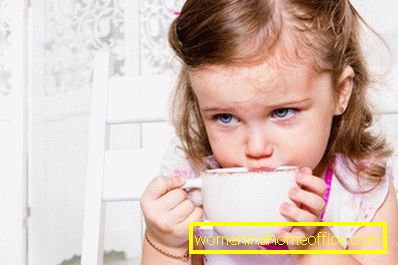Sinusitis in a child
The sinuses are moist air spaces inside the bones of the face around the nose. When they are infected, swell or irritated, it is called sinusitis. This condition usually follows a cold or allergic reactions. Consider sinusitis in children: symptoms and treatment.
Why does a "snotty disease" occur in a child?

In the bones of the human skull, there are four kinds of hollow spaces, classified as sinuses:
- in the upper jaw the cheekbones are maxillary;
- frontal;
- behind the nasal passages are the lattice labyrinth cells;
- deep in the brain behind the nasal passages - the sphenoid sinus.
These cavities are lined with mucous membranes. During a cold or allergy, the nasal passages become swollen, more mucus is produced, and this ultimately results in the drainage system for the sinuses being blocked. The result will be the growth of bacteria, viruses, fungi, and the result - sinusitis.
Doctors systematize sinusitis as follows:
- the nature of the flow - acute or chronic;
- by origin - viral, bacterial, fungal, mixed, traumatic, allergic, drug;
- by location:
- sinusitis - sinuses in the upper jaw;
- frontal sinus - frontal sinus;
- ethmoiditis - ethmoid bone cells;
- sphenoiditis - sinus in the main sphenoid bone.
The disease is capable of leaking in one of the sinuses or in several, and half of the face or both can also be affected. Additional factors predisposing to the occurrence of sinusitis are:
- tumors in the nose;
- deviation of the nasal septum from the midline;
- immunodeficiency;
- an asthma attack;
- hereditary diseases: cystic fibrosis, cleft lip, cleft palate;
- chromosomal pathology - Down syndrome;
- transposition of internal organs - primary ciliary dyskinesia.
Symptoms, diagnosis and treatment of sinusitis in children

Babies at birth, albeit small, but already have ethmoid and maxillary sinuses. They are developed unevenly. Maxillary sinuses are formed by three years, and frontal - by five. In the acute course of the disease, nasal congestion and the presence of discharge from it of yellow or green mucus are characteristic, manifestations of fever are possible, general malaise is observed. The pressure in the paranasal sinus corresponds to the appearance of pain. The pain also manifests when torso is tilted, teeth are compressed.
In the diagnosis, a differentiated approach should be applied to other diseases, such as:
- dental disease;
- angioedema;
- diffuse purulent inflammation of the fiber of the orbit, etc.
Chronic sinusitis is characterized by the following symptoms:
- swelling of the nasal mucosa on an ongoing basis;
- nasal discharge;
- unpleasant smell from the mouth;
- cough;
- decrease in taste and ability to distinguish odors.
Soreness in the paranasal sinuses when exposed to slight. Chronic sinusitis is characterized by exacerbations during the year. If symptomatic manifestations of the disease are observed for longer than a week, consultation of the doctor is necessary, since the probability of a concomitant bacterial infection and the emergence of the need for antibiotics is high.
The presence of relevant symptoms, increased ESR and an increased number of white blood cells in the blood test indicates the need for x-rays of the paranasal sinuses for diagnosis. Detection of thickening of the mucous membrane in children more than 4-6 mm, darkening and fluid indicates the development of sinusitis. Computed tomography provides an improved analysis compared to x-rays.
Principles of therapy
How to treat sinusitis in a child? Initially, the doctor will prescribe medication. Primarily used vasoconstrictor drugs to combat the swelling of the mucous membrane and stimulate increased drainage secreted from the sinuses. It is worth remembering that they can not be applied for more than 5 days.
Due attention should be paid to symptomatic and adjuvant therapy, which includes such measures:
- air humidification in the room;
- nutritional balance;
- increased fluid intake;
- taking painkillers of non-narcotic origin;
- exclusion of smoking and the presence of other factors that adversely affect the atmosphere in the room with the patient.
For the treatment of sinusitis caused by viruses, characterized by the use of saline nasal sprays and solutions. Antimicrobial therapy in determining the cause of sinusitis due to bacteria is based on the use of antibiotics. Drugs are prescribed individually, taking into account the age, tolerability of drugs, the duration of the disease and its causes.
For acute sinusitis, antibiotics are prescribed for up to 3 weeks. Treatment of the chronic form of the disease with antimicrobial agents is carried out up to 2 months. Mandatory treatment of concomitant diseases in case of their presence.
Pediatrician Komarovsky E. O. about yellow and green snot in children

Speaking about sinusitis in children, symptoms and treatment, Dr. Komarovsky notes that viruses, allergic reactions of the body, bacteria can be the causes of the disease. The mucus secreted from the concomitant rhinitis can vary from colorless secretions to a yellow or green hue.
The presence of a bacterial component and, as a consequence, the use of antibiotics is possible in such cases:
- if more than 10 days do not pass cough and green mucus from the nose, accompanied by other symptoms characteristic of sinusitis;
- in the event of symptoms, including green snot, with high body temperature for 3 days.
In order to determine the need for antibiotics, a pediatric doctor will conduct an examination and prescribe the necessary tests and studies.
Small children are prone to infections of the nose, sinuses, and ears, especially in the first years of life.
One of the first actions of parents when symptoms of sinusitis appear should be an appeal to a pediatrician. The common cold in children can have a severe course and serious consequences. No self-treatment, and if possible quick consultation with a pediatrician! Health to you and your children!